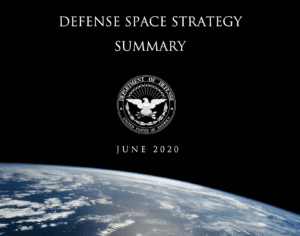 As part of the partnership between SpaceWatch.Global and the European Space Policy Institute, we have been granted permission to publish selected articles and briefs. This is ESPI Briefs No. 43: ‘The new U.S. Defense Space Strategy’, originally published in July 2020.
As part of the partnership between SpaceWatch.Global and the European Space Policy Institute, we have been granted permission to publish selected articles and briefs. This is ESPI Briefs No. 43: ‘The new U.S. Defense Space Strategy’, originally published in July 2020.
1. Overview of the strategy
 The Defense Space Strategy (DSS) published in June 2020 by the U.S. Department of Defense (DoD) is a follow-up of the National Strategy for Space and of the National Defense Strategy, both published in 2018. It supersedes the 2011 National Security Space Strategy, published under the Obama administration. More generally, the DSS is part of the reorganisation of military space activities undertaken by the current administration over the past years, and which culminated in 2019 with the creation of the U.S. Space Force (USSF), the U.S. Space Command (USSPACECOM) and the Space Development Agency (SDA).
The Defense Space Strategy (DSS) published in June 2020 by the U.S. Department of Defense (DoD) is a follow-up of the National Strategy for Space and of the National Defense Strategy, both published in 2018. It supersedes the 2011 National Security Space Strategy, published under the Obama administration. More generally, the DSS is part of the reorganisation of military space activities undertaken by the current administration over the past years, and which culminated in 2019 with the creation of the U.S. Space Force (USSF), the U.S. Space Command (USSPACECOM) and the Space Development Agency (SDA).
The DSS states that the U.S. military space enterprise is not adapted to the current strategic environment, described as “a great power competition”. Quite unusual for this kind of document, the countries that the current administration considers as adversaries of the United States are explicitly named, through accusatory wording. Indeed, the DSS specifically points at Russia and China as countries presenting the “greatest strategic threat” to the United States and assert that they have “weaponized space as a means to reduce U.S. and allied military effectiveness and challenge [U.S.] freedom of operation in space”. The identified consequence is the need for the country to get ahead of its adversaries in order to achieve space superiority in ten years.
Finally, the DSS endorses the important shift in the U.S. approach to space defence. Consistently with previous statements of U.S. officials, the Strategy tasks the U.S. Department of Defence to “rapidly transform its approach to space from a support function to a warfighting domain”. The DSS takes into account the premise that in-space military operations can be carried out, which paves the way to space-to-space conflict and raises questions about the capabilities planned to be developed for these activities: does the United States plan to deploy weapons in space? Answers to this question are likely present in the full version of the Strategy, which has not been made publicly available.
2. A limited evolution compared to the 2011 document
A comparison with the 2011 National Security Space Strategy shows that the main input of the DSS is a stronger emphasis on the operational use of space, especially directly in space, for military purposes. The importance attributed to space operations is shown by the objectives stated in the DSS, while space stability, ranked as the top goal in 2011, now seems to be given more secondary priority.

While the objectives identified now focus on the operational use of space systems for military purposes, the strategic approaches proposed, called “lines of effort”, are comparable to the ones outlined in the 2011 document. However, they have been reorganised according to revisited priorities.

These lines of effort will be implemented through measures of different nature: organisational; capability- building; “conceptual” (development of expertise, doctrine and operational concepts); and diplomatic and cooperative measures. In addition, the Strategy stresses the rapid pace that must be adopted to reach U.S. objectives in ten years. Overall, the DSS remains in the continuity of the 2011 National Security Space Strategy; yet, priorities have been reorganised and two elements stand out: the DSS is more assertive, using stronger words; and the emphasis is put on operations in space, in line with the reconnaissance of space as a warfighting domain.
3. A strategy illustrating the change of U.S. leadership foundations
Finally, the Strategy also calls for greater cooperation, both with private actors and with international allies and partners, in particular for future capability development and operations. The DSS makes clear that part of the rationale behind this call for cooperation is ”burden-sharing”, but the United States is also interested in collaborating to benefit from its allies’ space programmes. Moreover, these collaborative efforts will be given significant attention in the short-term, therefore, the place that Europe wants to take in this framework should be raised now.
Given the disparity among European states regarding their military space programmes, the involvement of European actors will likely vary from one country to the other. Currently, the interest of the United States seems to be restricted to those nations that already possess relevant capabilities. Indeed, during the presentation of the DSS, Stephen Kitay, Deputy Assistant Secretary of Defense for Space Policy, stressed the participation of France, Germany and the United Kingdom in the Combined Space Operations Initiative, but did not mention other European member states. It illustrates a change of mindset from U.S. officials: traditionally in the post-World War II era, the United States used to position itself as the champion of the “free world”, seeking adhesion of like-minded allies according to common or broadly shared values. However, cooperative measures in the DSS are rather an invitation made to carefully selected potential partners to support a U.S. strategy based on a capacity-driven approach. The nature of the U.S. leadership may thus be questioned. Americans have been so far successfully implementing a “soft power” strategy, which is being challenged in an unprecedented manner. Indeed, the United States is now shifting to a strategy of “resolute” leadership, emphasising power and combining both assertiveness/confrontation and receptiveness/cooperation. The former is visible in the space defence domain, while the latter is demonstrated in the space safety and exploration domains. This might in turn result in polarising the international space scene. Seeking consensus in international space affairs has been so far the rule irrespective of overarching geopolitical tensions. Will space continue to benefit from its relative immunity to international tensions? Or will it become the next focal point for diplomatic disputes?
Rights reserved – this publication is reproduced with permission from ESPI. “Source: ESPI “ESPI Briefs” No. 43, July 2020. All rights reserved”
For more articles please visit ESPI website (www.espi.or.at).
 SpaceWatch.Global An independent perspective on space
SpaceWatch.Global An independent perspective on space




